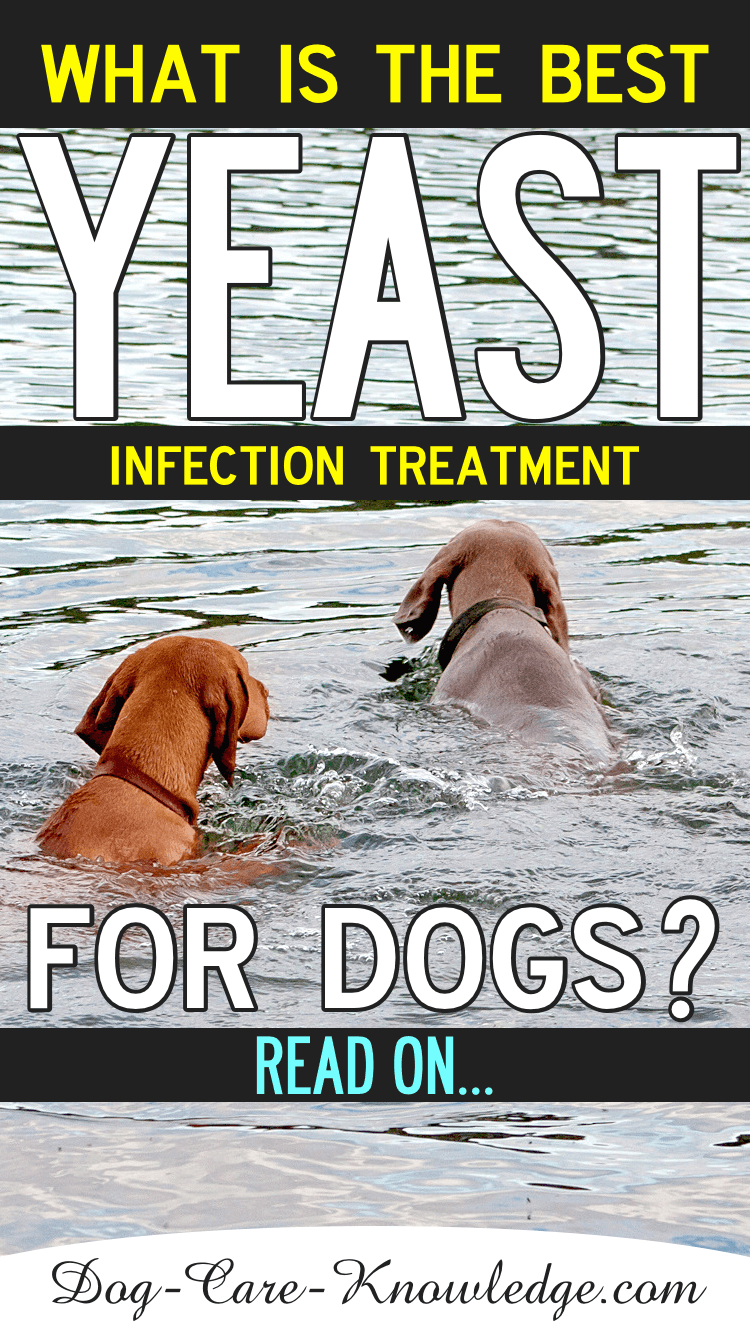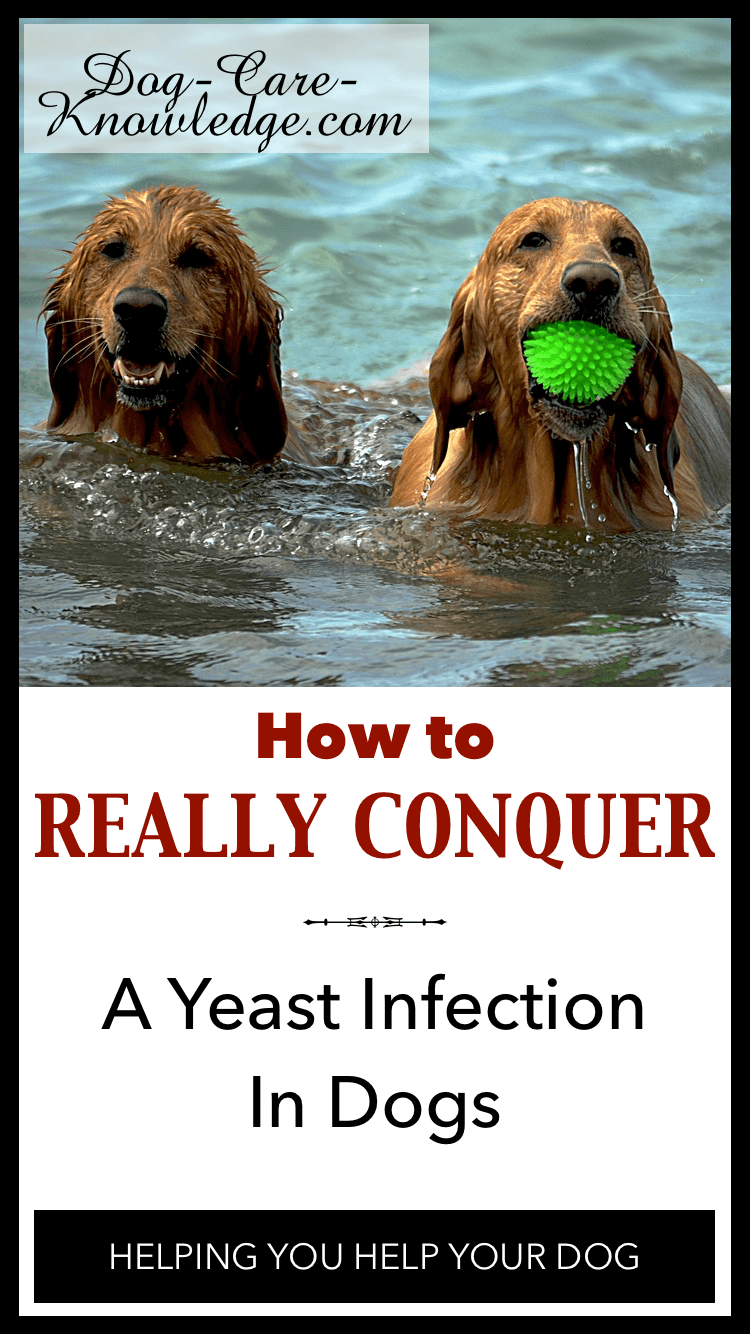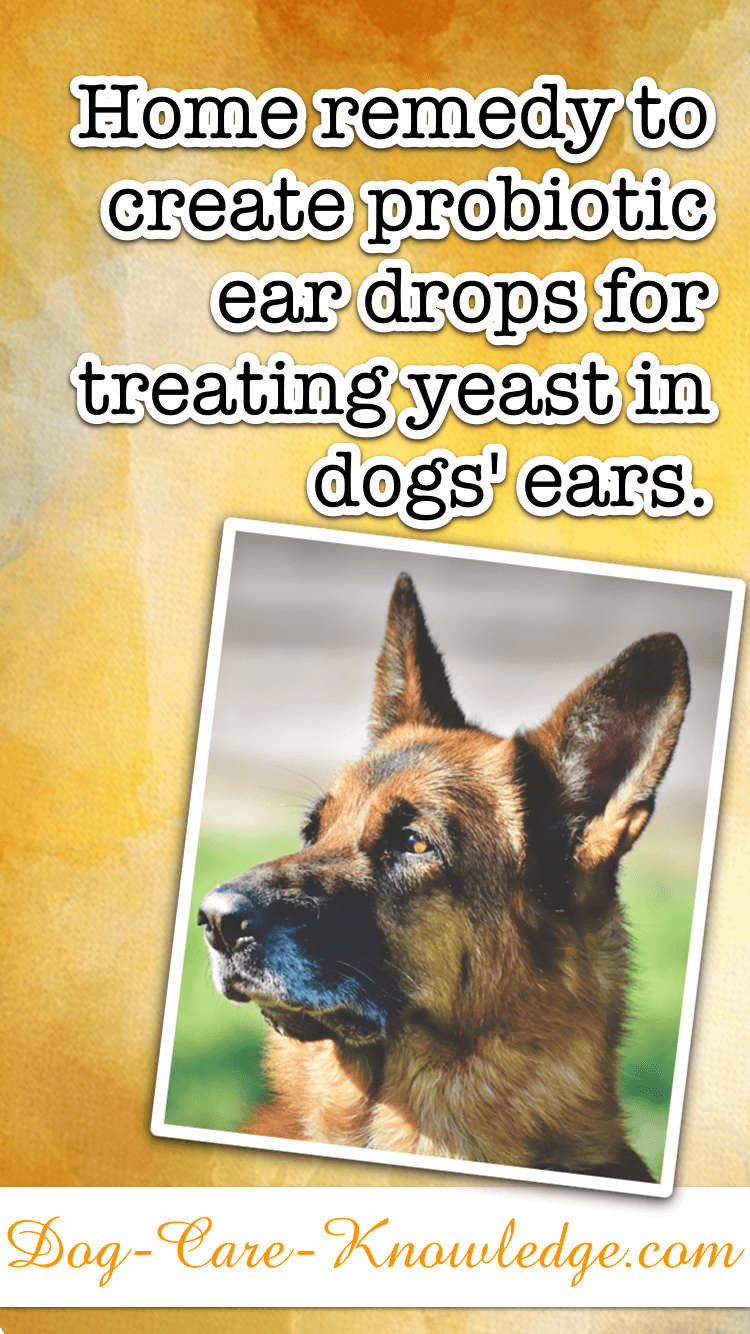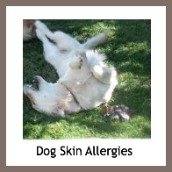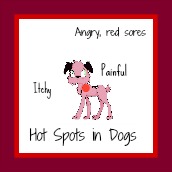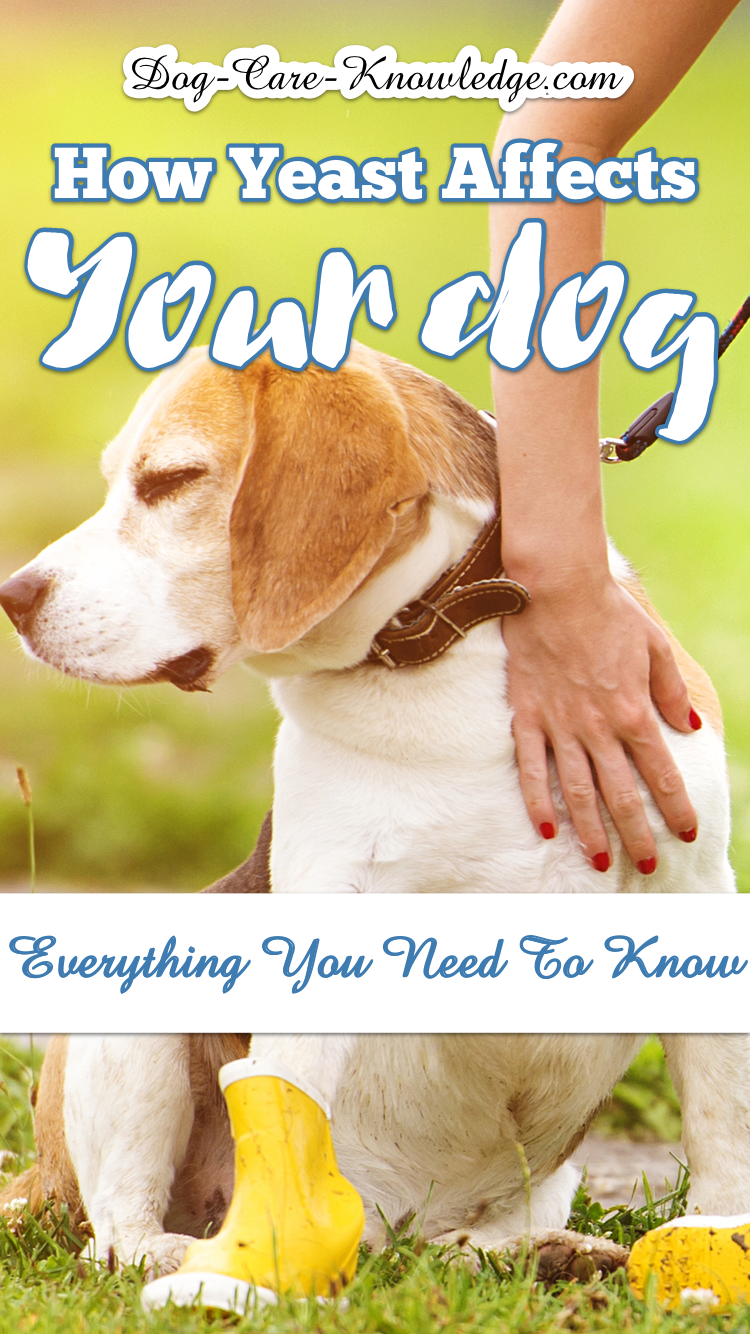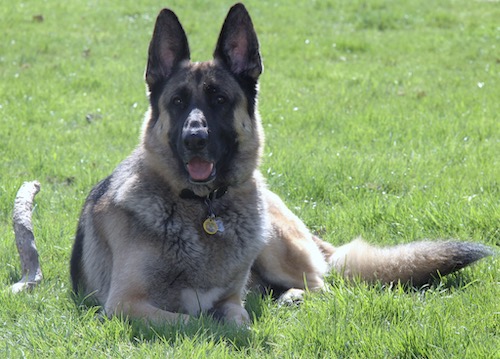- Home
- Skin Conditions
- Dog Yeast Infection Treatment
- Home
- Itchy Dog?
- Dog Yeast Infection Treatment
Dog Yeast Infection Treatment
Want the best yeast infection treatment for your dog?
So did I.
That's why I researched many books, websites, articles, journals, and consulted with veterinarians to find out what works best for my dog's yeast infection.
This page is the result of that research.
It's also a long page, feel free to use the below links to jump straight to something in particular you want to know.
Or, read on.
What is a Yeast Infection in Dogs?
Before we get to the treatment, here's a quick review of what a yeast infection is and how you know whether or not your dog has one.
Yeast is a fungus that occurs naturally on a dog's skin and in the digestive tract. It usually causes no problems except when a) it grows out-of-control and b) when your dog is allergic to yeast.
An overpopulation of yeast can occur when your dog's immune is compromised leading to a yeast infection. The immune system can be weakened by another illness, antibiotic use, or prolonged use of steroids.
Yeast Infection Symptoms
Common symptoms of yeast infections include lots of scratching, itching and a pungent smell. Yeast likes a moist environment, so the most affected parts are the ears, paws, groin, and any skin folds. If you see your dog shaking his head a lot, chewing or licking the paws, or scooting his butt, it's possible he has a yeast infection.
If you suspect your dog has a problem with yeast, speak to your veterinarian who can conduct a skin test to give an accurate diagnosis. It's vital that you don't try any remedies without first getting a confirmed diagnosis, especially if the ears are affected. External ear infections respond well to home remedies, but a veterinarian should be the only person to treat middle or inner ear infections.
Treatment for a Yeast Infection in Dogs
Most yeast infections in dogs can be treated at home.
The secret to really conquering it is with a two-pronged approach:
1) Treat the gastrointestinal (GI) tract.
and
2) treating the local skin area.
By using this two-pronged approach gives you a much greater chance of managing a yeast infection in your dog.
1) Treating the Digestive Tract
70% of your dog's immune system resides in the GI tract. By starting at the digestive tract gets to the root cause of many skin issues in dogs, yeast included.
The first thing to do is to ensure your dog’s immune system is getting all the essential nutrients it needs. One of the most common causes of dry, flaky, itchy skin in dogs is a lack of essential fatty acids (EFAs). Most dogs fed on commercial dog foods are deficient in omega-3 which is an EFA for optimal skin health.
Adding essential fatty acids (EFAs) to your dog's food is an excellent way of ensuring your dog’s immune system works optimally. The EFAs that work best, in this case, are omega-3 and omega-6.
Wild Alaskan salmon oil is a supplement that has an abundant supply of pure, natural, omega-3 and omega-6 oils.
These oils have proven abilities in providing the immune system with the nutrients it needs.
If you do nothing else, adding this supplement to your dog's food should result in considerable improvement.
Boost Immune System
Once you have the basic needs of the immune system covered by adding EFAs, adding some excellent herbs can provide a boost. Boosting the immune system makes it stronger which helps your dog to keep yeast in check over the long run.
Herbs are both nutritious and medicinal, but they are not drugs. They also don’t carry the long list of side-effects that many drugs possess. Having said that, anyone or dog can be allergic to anything including herbs, although the incidences are rare. Typical reactions are usually milder than Western medicine and almost always stop with discontinuation of use.
One word of warning, used incorrectly they can be toxic or lethal, but again, there is a low occurrence of this happening. To give you a comparison; Traditional Western drugs cause an estimated 10,000 deaths per year, but herbs have caused approximately 100 deaths over 10 years.
Like-for-like, that’s 10,000 to 1 or 100,000 to 100.
Herbs That Boost the Immune System
- Alfalfa – This herb contains a broad spectrum of nutrients that aid in building a robust immune system. It is very high in protein and includes; trace minerals, dietary fiber, and vitamins A, B1, B12, C, D, E, and K. It’s also high in chlorophyll which serves as a natural antioxidant in the bloodstream.
- Astragalus – widely used in Chinese medicine for thousands of years as an immune booster and energy tonic. Astragalus has also been used in Western herbalism due to its versatile immune-strengthening qualities. It also possesses anti-bacterial, anti-inflammatory, and antiviral properties. Astragalus also contains swainsonine which is an alkaloid that inhibits the spread of skin cancer.
- Echinacea Ang. Root – best known for its actions in balancing the immune system, Echinacea has proved useful in fighting many conditions from infections to insect bites. Echinacea's primary activities are as an immunostimulant and antimicrobial. Its strongest affinity has always been to the immune system, lymph system and urinary tract.
- Eluthero – is used to stimulate the immune system but can also enhance endurance, stimulate the thyroid and adrenal hormones, and regulate blood sugar.
- Oatsraw Green Tops - Used extensively as far back as the Middle Ages, Oatstraw has been used for its nutritional benefits. It improves nerve function and has anti-inflammatory properties which serves to support the nervous system.
These herbs should be available from most health food stores. They can be used fresh, dried, or made into teas or tinctures that can be added to your dog’s food.
Alternatively, try Glacier Peak Immune. This is a 100% holistic remedy that includes all of these herbs and more.
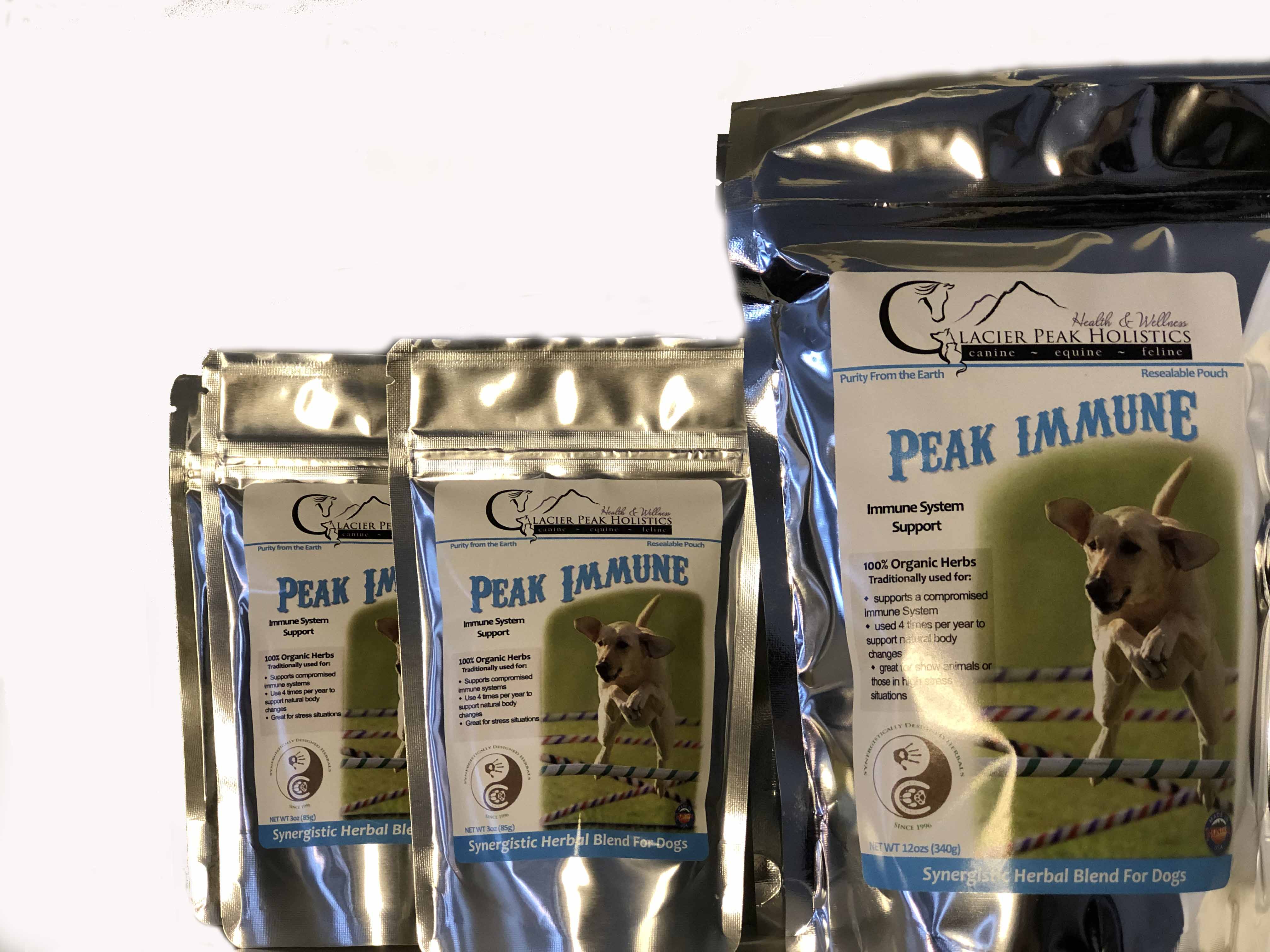
Grapefruit Seed Extract (GSE) or (GFSE)
GSE or GFSE has been reported on many websites as having excellent anti-fungal abilities.
Side Note: Both acronyms (GFSE and GSE) refer to grapefruit seed extract. It used to be known as (GSE). GSE was frequently confused with grapeseed extract, which is an entirely different product. So an “F” was inserted to distinguish it from "grapeseed extract." I'll be using the GFSE acronym here.
I was therefore all set to include a section here on how wonderful the herb GFSE is for treating yeast in dogs. That is, until I conducted a thorough investigation into potential side effects (as I do with all products I recommend). It was here that I found many startling negative reports spanning 15-20 years of testing.
I include a direct quote from one of those studies below. The gist of these reports state that most GFSE has been found to contain harmful ingredients usually found in synthetic disinfectants. The results of the test conclude that the GFSE products that show antimicrobic activity (i.e., antifungal) have been adulterated with synthetic ingredients.
Those that are pure GFSE and contain no harmful ingredients demonstrated no antifungal properties. They concluded that it was the artificial ingredients that were killing fungus, not GFSE.
After much research and many hours of reading, I’ve concluded that I cannot recommend GFSE as a safe or effective natural remedy for treating yeast, or anything else for that matter. I know many websites are touting the wonder of GFSE, but I urge you to conduct your own research before trying it yourself.
Here is a direct quote from one of the studies.
“A significant amount, and possibly a majority, of ingredients, dietary supplements and/or cosmetics labeled as or containing grapefruit seed extract (GFSE) is adulterated, and any observed antimicrobial activity is due to synthetic additives, not the grapefruit seed extract itself. Tests conducted in multiple laboratories over almost 20 years indicated that all commercial GFSE preparations that exhibited antimicrobial activity contained one or more synthetic microbicides/disinfectants, while freshly-prepared extracts of grapefruit seeds made with a variety of extraction solvents neither exhibited antimicrobial activity nor contained the synthetic antimicrobial compounds found in the commercial ingredient materials.”
Source: Herbalgram.com
Dog Yeast Infection Treatment - Diet
Dogs plagued by yeast should have sugar and carbohydrates cut from their diet.
Yeast feeds on sugar, and a diet high in sugar will make a yeast problem worse. That includes carbohydrates as carbohydrates break down into sugar once in the system.
Dogs on a dry kibble diet are particularly vulnerable as most kibble is full of carbohydrates. Grain-free diets are not carbohydrate-free, grains as typically replaced with carbohydrate-rich potatoes. The best way to avoid sugar and carbs is to feed raw or homemade food.
It's not just dog food that is high in carbohydrates; many store-bought dog treats are loaded with sugar, starches and unnecessary fillers.
For Ava, and because she's allergic to yeast, I switched her to a raw food diet and only use treats I make.
If you’re unsure how, or even if, you want to get started with raw feeding then there are plenty of resources to help you get started.
- https://raw-roundup.com
- https://rawandnaturaldogsummit.com
- https://www.dogsnaturallymagazine.com/raw-feeding-primer/
Probiotics
Probiotics are probably the most vital supplement for a dog suffering from a yeast infection.
Probiotics are friendly bacteria that live in the gut and provide a natural defense against harmful bacteria and yeast. All dogs (and humans) have a certain amount of yeast in their system. It only becomes a problem if the yeast starts to grow out of control and takes over. Probiotics prevent this from happening by crowding the yeast out. But not all probiotics are created equal, and not all probiotics are suitable for canines.
To ensure you choose a quality probiotic for your dog, select one that has been formulated for dogs, has at least 10 strains of probiotics and includes the strains; Lactobacillus Acidophilus (L. Acidophilus), Bifidobacterium Bifidum (B. Bifidum) and Lactobacillus Rhamnosus (L. Rhamnosus). These have been reported as combating yeast.
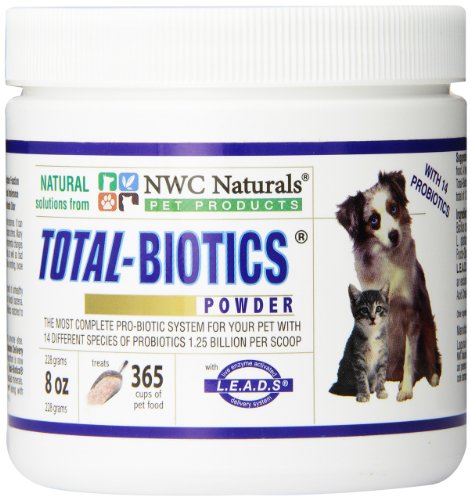
After much research I highly recommend (and use) 'Total-Biotics'. Here's why..
- Formulated by a Naturopathic Doctor
- Contains 14 strains of probiotics
- Made specifically for dogs & cats
- Made in USA
- GMP compliant (made in a facility that follows good manufacturing practices).
Canine Digestive Enzymes
Most dogs will benefit from a supplement that contains digestive enzymes to aid in the proper balance of nutrients and enzymes in their body. The process of cooking commercial dog food typically destroys the delicate digestive enzymes and nutrients required to keep your dog's skin healthy and the immune system robust.
By providing a supplement rich in nutrients and enzymes you can restore your dog's skin and boost his immune system.
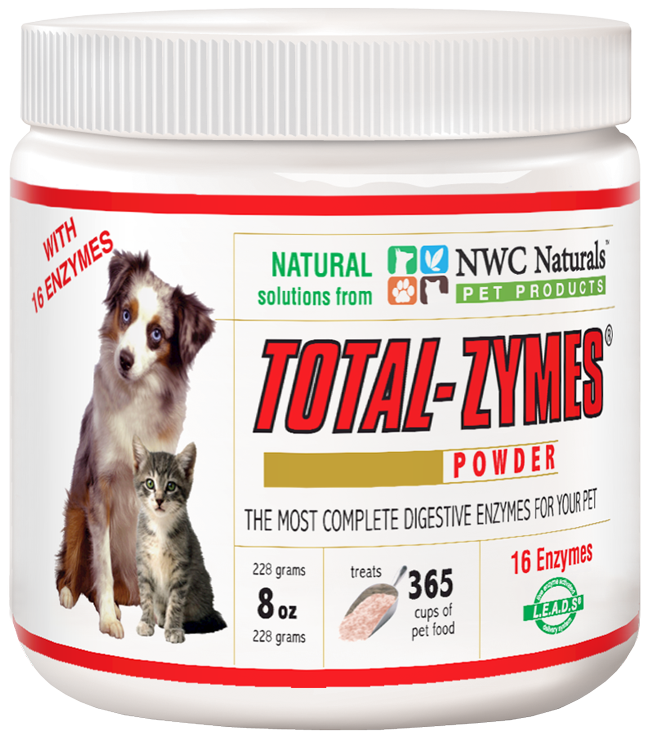
I recommend NWC's Total-Zymes Pet Digestive Enzymes.
It has 16 different enzymes that work as a high-performance digestive enzyme improving your dog's absorption and utilization of nutrients.
Plus, it works perfectly with Total-Biotics to enhance a dog's immune system.
Antifungal Herbs That Fight Yeast
Although there are prescription antifungals that fight yeast, many have nasty side-effects and yeast has become resistant to some of these medications.
Fortunately, nature has a solution with many herbs containing powerful antifungal properties. Here is a selection of herbs that can do a good job, if not better, than prescription medication.
Olive Leaf - is a proven and active antifungal agent that targets and inhibits the growth of yeast. Studies were carried out in 2015 and 2016 on the effectiveness of olive leaf against yeast both proving that products containing olive leaf would be effective against fungus.
Olive leaf - is also a natural herb that can be easily cultivated into a tincture that can be used as a home remedy against yeast infections in dogs.
Astragalus - Antifungals do an excellent job of killing yeast; however, when yeast cells die they release toxins in the body that can cause die-off symptoms leaving your dog feeling poorly. It's therefore essential to include antioxidant and detoxification support when using antifungals to help the liver eliminate these toxins. It's also important to keep the immune system healthy.
Astragalus has been used for centuries in Chinese medicine to boost the immune system. It also has mild antifungal activity and potent antioxidant properties that provide ideal support for protecting against die-off symptoms.
Black seed has significant antifungal properties. A study published in the Avicenna Journal of Phytomedicine showed black seed was proven effective against killing Candida Albicans which is one of the common strains of yeasts.
Pau d'arco is native to South America and has been used for medicinal purposes since 1873. It's a well-known antifungal agent due to two active chemicals that kill fungi, bacteria, viruses, and parasites. They are lapachol and beta-lapachone. Beta-lapachone has been proven to inhibit the enzymes in virus cells preventing it from replicating itself or infecting other cells.
Pau d'arco also has antioxidant properties that make it a useful fighter against yeast.
Clove Bud is a popular antifungal that is frequently included in treatment plans for dog yeast infections. Containing a variety of agents that fight yeast including:
Eugenol, Eugenyl acetate, Caryophyllene, and Iocaryophyllene. The most potent agent clove possess Eugenol which not only kills Candida yeast cell but acts as a potent stimulant to the immune system.
You can grab a selection of these herbs, or other herbs with antifungal properties, and make a powerful antifungal home remedy.
Alternatively, try Glacier Peak Gold that has these herbs plus many others blended into a propriety blend that fights yeast infections in dogs.
Glacier Peak Gold is made up of 100% organic herbs. These herbs have been carefully selected to kill yeast, boost the immune system, and provide effective antioxidant and detoxification support.
2) Treating the Area Topically
Bathe With Anti-fungal Shampoos
As yeast is a fungus, it must be treated topically with regular baths using anti-fungal shampoo. It's no good treating the digestive tract if you leave the existing yeast on your dog's skin!
Bathing your dog regularly with a good quality anti-fungal shampoo will control the amount of yeast on your dog's skin and reduce the itching. Neem dog shampoo is a good choice, you can find more details of how neem works here.
Even if your dog only has yeast on specific areas, such as the ears and paws, it's imperative that you bathe the entire body to control a yeast infection in dogs.
Using a shampoo that contains an anti-fungal agent is best. Preferably one using natural ingredients as too many harsh chemicals will strip your dog's skin of its natural oils. And, given that you'll need to bathe frequently to keep the yeast at bay, you need a shampoo that's also kind to your dog's skin. Following with a good quality conditioning rinse will also help to re-moisture the skin and coat.
Treating the Paws
If your dog is always chewing her paws, try washing them daily with the antifungal shampoo. You can also use an anti-fungal spray to disinfect the paws daily. Just ensure you get the liquid deep in-between the toes as that's where it gets itchy the most!
Treating Dog's With Ear Yeast
Warning: If your dog is tilting her head to one side and cries or whines when the ear is touched, you must take her to a veterinarian for a proper diagnosis. Dog's will often hold the head down on the painful side.
Dogs' ears are very sensitive, so it's essential that you handle a yeast infection in dogs’ ears a bit differently. Most sprays are too harsh for the ear canals, some are OK, but check on the label first.
When your dog's ears are infected, anti-fungal eardrops will probably be needed. For dogs that won't hold still, speak to your veterinarian about Claro Otic Solution. It's a treatment that only requires one application but MUST be administered by a licensed veterinarian only.
Claro Otic Solution contains three active ingredients: florfenicol (antibacterial), terbinafine (antifungal), and mometasone furoate (steroidal anti-inflammatory). It works quickly but does include a steroid. It's effective for 30 days.
A good OTC alternative is Zymox which you use once a day for 7 days or for chronic infections, treat once a day for 14 days.
Home Remedy for Yeast
For yeast infections of the ears, you can create your own eardrops using a friendly strain of bacteria which targets yeast. L acidophilus is a good one to try or a product that contains this.
Before you do this, check with the manufacturer to ensure their product is safe for use in a dog’s ears.
Although the ear canal is not a typical environment for probiotics - they usually live in the gut intestines - they can help cut down on the amount of yeast in your dog's ears.
If your dog's ears are anything like Ava's where the yeast comes back as soon as I clean the ears out, you can try the below method.
Probiotic Ear Drop Recipe
Ingredients:
- 1/4 scoop Total-Biotics power or equivalent
- Water
Method:
- Clean your dog's ears with a natural dog ear cleaner.
- Ensure you dry the ears thoroughly, and all water is out.
- Mix 1/4 scoop of Total-biotics with 1 ounce of water.
- Use an eyedropper and squirt deep into the ear canal.
- Allow your dog to shake his head.
- Leave acidophilus residue in the ears (it will crowd out yeast before dying out).
- Repeat periodically (see 'how often' below).
As mentioned above, the typical environment for probiotics is in the gut so it will not survive long in the ears, but it should be long enough to attack the yeast and chase it out. You'll need to repeat this until the yeast is under control.
How Often to Use Probiotics Topically
- For severe yeast = twice a day
- Prevention treatment for dogs that suffer from repeated ear infections = once a week
- Dogs with drier ears = once a month
Yeast On Other Problem Areas
There is research showing that the ears, the oral cavity and so on, all can support and need good bacterial colonization. By creating and applying a homemade remedy containing probiotics you can crowd out yeast and bad bacteria topically.
If your dog suffers from yeast on other areas of her body such as armpits, anal area, or skin-folds, then you can treat topically with the home remedy above or use an anti-fungal spray.
Although I think all of these options work well, I just want to mention that since Ava has been undergoing her allergy shots, I haven't had to use the ear ointments at all.
She underwent allergy testing in 2016 and it is now three years later (2019) and her ears are finally clear. You can find out more about canine allergies here, and decide whether it's something you think will work for your dog.
If you're still not sure that it's yeast your dog is suffering from
click here for more information on Dog Ear Care.
Dog Yeast Allergy
If you have a dog, like mine, that is allergic to yeast you might want to consider allergy shots to help your dog develop resistance to the fungus.
The most significant difference between a yeast infection and a yeast allergy is the smell. A dog suffering from overpopulation of yeast will likely have smelly ears and paws. A dog that is allergic to yeast doesn't usually have enough of it to smell.
If you're not sure then speak to your veterinarian about allergy testing or you can find a Veterinary Dermatologist here.
To Summarize
A yeast infection in dogs is prevalent in warm weather and often gets misdiagnosed as allergies. If your dog is scratching her ears, chewing at her paws, and doing a lot of butt-scooting, then she may have fallen prey to the dreaded yeasty beasties.
You'll see this much more often in the spring and summertime as yeast proliferates when the weather gets hot and humid.
Bottom line, treating yeast infection in dogs requires a two-pronged approach; treating the digestive tract and topically on the skin. The best way to do this is with anti-fungal shampoos and sprays along with probiotics, herbs and wild Alaskan salmon oil. If you have a dog that suffers from chronic yeast infections, then dietary changes may need to be made.
Source/Reference
Velegraki A, Cafarchia C, Gaitanis G, Iatta R, Boekhout T (2015) Malassezia Infections in Humans and Animals: Pathophysiology, Detection, and Treatment. PLoS Pathog 11(1): e1004523. https://doi.org/10.1371/journal.ppat.1004523
Kidd, R. (2000). Dr. Kidds Guide to Herbal Dog Care. Pownal, VT: Storey Books.
Tilford, G. L., & Wulff-Tilford, M. (2010). Herbs for Pets. Irvine, CA: BowTie.
